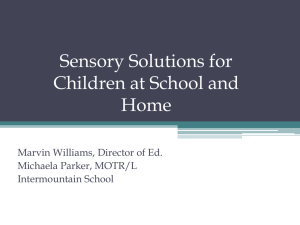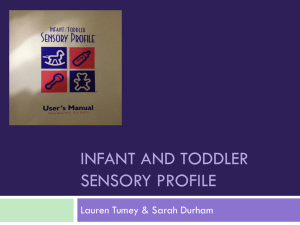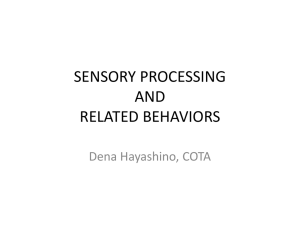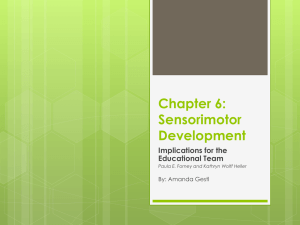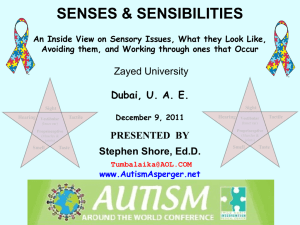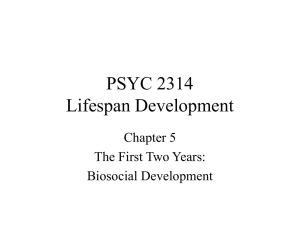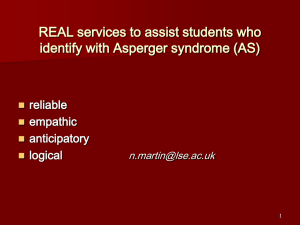Power Point - Rising Abilities
advertisement
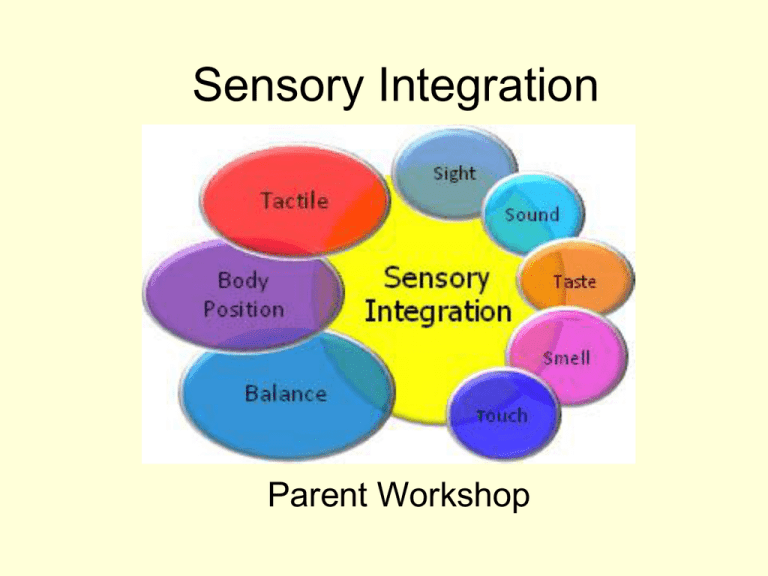
Sensory Integration Parent Workshop The 5 senses • The commonly known senses – • These keep us informed about what is happening outside our body PROPRIOCEPTION • Sensations from joints and muscles • The body’s A-Z (Map) • We can always tell the position of our body, without even looking VESTIBULAR SENSE Found in the inner ear Sends information to our brain regarding: - balance - movement - muscle tone Coordinates eyes, head and body Sensory Integration • Sensory Integration • How the brain organises sensory information for use • Can explain the relationship between brain and behavior Why consider Sensory Processes? Sensory vs. Behavior • All sensory process have a behavior/emotional component BUT • Not all behavior has a sensory component • All behavior is communicating a need Effects of Sensory Integration Difficulties Motor Skills Attention An Analogy The link between brain and behavior Brain: Behavior: Hungry – Seek more Sensory input Just Right – Play, Work, Learn Avoid Stuffed Full - Displaying Negative Behaviors to express overload Hungry Sensory Seeking Poor Registration Under Responsive Over Responsive Sensitivity to Stimuli Sensory Avoiding Stuffed Full The Hungry child • Needs a lot of sensory information • May over-respond to sensory information – – – – – – Sensory seeking Over-active Flighty attention Passive “Day dreamy” Miss important instructions The Stuffed Full child • Does not need a lot of sensory information • May over-respond to sensory information – – – – – – – Sensory Avoiding Doesn’t like clutter May like clear spaces Doesn’t like crowds Be very controlled/controlling Doesn’t like noises Be very picky Does SI affect Learning? Yes….because learning requires • The child’s behavior and alertness to be in an optimal state to maintain attention to tasks. • The child’s motor skills to be in an optimal state to perform and learn new tasks successfully. Does SI affect Behavior? YES… When sensory input is confusing or upsetting, the child may actively avoid the situation, become upset or have an emotional outburst . When the child does not register enough stimulation he may seek it out by constantly moving, chewing, humming, or flapping or he or she may seem tired, uninterested and passive. He may rummage cupboards seeming to be in search of food even when full. Sensory Modulation • How the child responds to sensory information • Alerting • Calming Poor Adaptive Responses • Fright • Flight • Fight Provide a Balanced Diet Morning Routine • Alerting – – – – – – Vibrating Toothbrush Crunchy Cereal Trampoline Simon Says Game Shower Cold, cold milk • Calming – – – – Graduated Light Gentle Music Alarm Weighted blanket Carrying clothes to utility room – Carry own school bag – Chewy cereals After School/Homework • Alerting – – – – – – – – Playground Crunchy Snack Cold Drink Sour Candies Dancing Music Vibrating Cushion Movement breaks • Calming – – – – – – – Playground Chewing gum Heated Room Bath Blowing bubbles Fidgets Cushions Bed Time • Alerting – – – – – Exercise/Games Vibrating toothbrush Cold Drink Music Scented candles • Calming – – – – – Weighted blankets Tight clothing Heated Room Calming songs Read story without pictures – Bath Some useful books • The Out of Sync Child Has Fun: Carol Stock Krankowitz • Parenting a Child with Sensory Processing Disorder: Christopher Auer and Susan Blumberg • Raising a Sensory Smart Child: Lindsey Beil, Nancy Peske • Building Bridges through Sensory Integration: Ellen Yack, Paula Aquilla, Shirley Sutton • Too Loud, Too Bright, Too Fast, Too Tight: What to do if you are defensive in an overstimulation world: Elaine Wilson and Helen Edwards Some Useful Websites • • • • Sensory Integration Network Sensory Integration International Sensory Smart Sensory Integrative Dysfunction in Young Children


